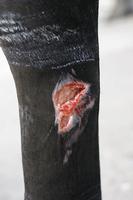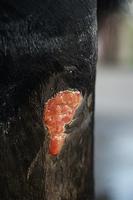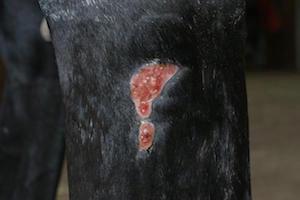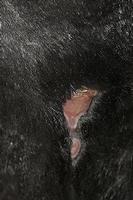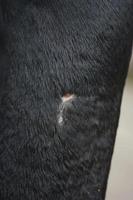It was 7am on a beautiful Saturday morning in early July 2013 and walking into our barn, the first horse I saw as always, was Solstice – 16.3hh, very dark bay, black really, a stallion and at just six, still full of mischief after a night in the stable.
Wondering what he’d been up to as he was standing with his head in a back corner, I first noticed the water bucket was missing – hooligan I thought – but then realised the heavy duty water bucket bracket held on with two large coach bolts was also off the wall completely and at the same time, I saw the first of the blood on the stable wall.
Going into the stable, his bed had a lot of blood in it, it was all over both hind legs and he was standing with his weight off his left hind leg. The water bucket bracket was at the opposite side of the box, quite badly bent.
He didn’t move whilst I put his head-collar on and was very lame when I led him out of his box and tied him up for a better look. Several wounds were visible and I decided not to mess about and just call the vet, as I thought he may have a wound that penetrated a joint – fetlock or hock.
20 minutes later and the vet started cleaning him up. The good news was that he hadn’t done any damage to either of his fetlocks and his right hind had only superficial cuts. However the left hind had fared worst, with three wounds below the hock on the outside of the leg. Each wound was more than an inch long and they were fairly deep. But the wounds were close together and clean cuts, so they were stapled, anti-inflammatories and antibiotics prescribed and an optimistic prognosis of – 10 days and staples out, should heal fine – was delivered.
He was turned out all day every day to try and keep the swelling of the wounds down as he wasn’t too lame thanks to the anti-inflammatories, but within 3-4 days, the wounds had all broken down. The staples were removed and we had several days of increasing swelling and never-ending quantities of serious fluid draining out of the wound, which was bandaged twice or three times daily and kept dry as far as was possible. Several vet visits, including one evening for a developing cellulitis, together with growing quantities of anti-inflammatories and antibiotics, didn’t seem to be improving the wounds.
We started walking him in hand around the arena and fields, five or six times a day for up to half an hour and he was still being turned out to graze and wander the rest of the day. The whole leg was cold-hosed through ice cubes in a double layer of tubigrip several times a day, but progress was slow and at the same time, the wound continued to break down as the severely bruised tissues died, hence the wound got larger and deeper. After each ice/hosing session, we cleaned the wound, and were careful not to touch it and re-bandaged. Then we turned a corner.
On Day 14 we borrowed an ArcEquine microcurrent tissue repair system from a friend and following the detailed instructions for wound healing. We started using ArcEquine on the opposite hind leg every day for a three hour “treatment”, as it isn’t necessary to use it on the injured leg. The dressing of the wound was changed twice daily due to the fluid still draining out of the wound, but we kept it totally clean, there was no smell and is was obvious that the wound had started healing in earnest.
A photograph was taken on Day 23 and what a difference! The swelling had reduced significantly, the wound had all filled in and dried up and somewhat unbelievably there was new skin growth, with black hair, clearly visible all round the edges of the wound.
We were still using the ArcEquine daily and still walking in hand. Solstice continued to be an absolute gentleman and he was obviously enjoying our walks around the fields. He was by this time sound again. By Day 40 and then Day 53 the healing rate of the wound actually seemed to have increased and his leg was looking more normal, although the wound was still “filling” overnight in the stable. The new skin and hair could clearly be seen and he was much less sore. We started a little work on the lunge and walking under saddle.
Day 74 this was the day all dressings came off – yippee! We were still using the ArcEquine and were so impressed with the results in terms of both the rate and quality of the wound healing and also they way in which Solstice had coped with everything (the ArcEquine calms horses in addition to repairing tissue) that we bought one – and have since found other uses for it.
Gradually, the remaining filling in the leg disappeared, all the hair grew back and at just over four months since the wound injury, we were left with only a degree of “thickening” in the area of the leg around the wound, where the worst of the bruising must have been.
Now a year later, with continued use of ArcEquine the thickening has almost gone and there is just a very small raised area of skin that is missing very little hair and to all intents and purposes, Solstice has made a complete recovery without even a cosmetic “legacy”.





